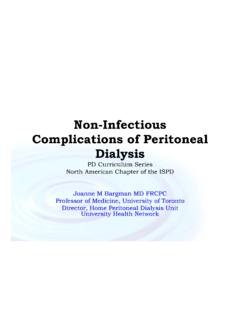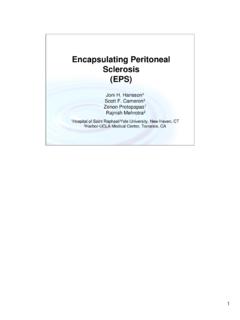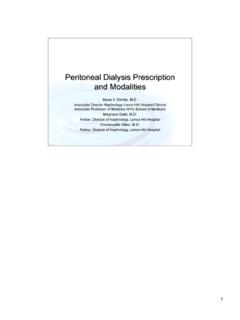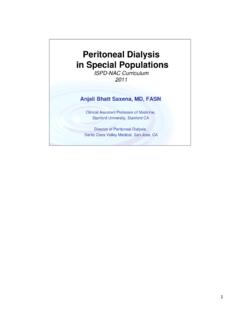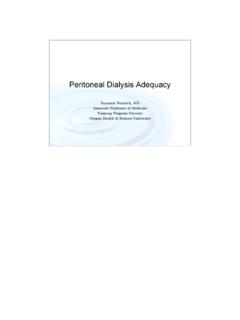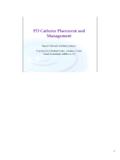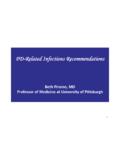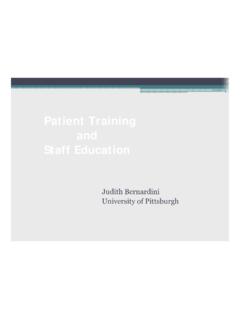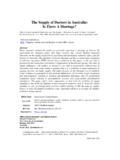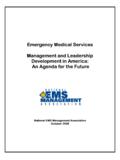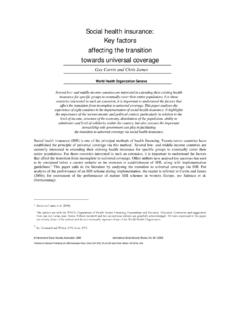Transcription of Finances of Home Dialysis: Facility and Physician …
1 Finances of home Dialysis: Facility and Physician PaymentsThomas A. Golper, MD, FACP, FASNV anderbilt University Medical CenterNashville, Conflict of Interest Disclosure: Honoraria or consultation fees received from Baxter Healthcare, DaVita, Fresenius North America, Genzyme Outline/Summary dialysis Facility payments Infrastructure Revenue and expenses Medicare Bundling Physician payments Hospital Office Medical directorshipDialysis Facility PaymentsKey Components to a Successful home Program *Staffing types, patient:nurse ratios, services linked to patient numbers, medical certification, reimbursement Standardized protocols, flow charts Key quality characteristics for improvement, collect sufficient data pointsIntegrated treatment strategyStage 4options educationUnit organization*Standardized processes of care Quality measurement tools Staff education and development(courtesy of Marty Schrieber)
2 Life PlanHome dialysis InfrastructureAdministrative Advantages/disadvantages of LDO affiliation Staffing Care delivery Secretarial support Space Supplies Pharmacy BillingCare delivery Primary care nursing Physicians Back-up dialysis Surgical support Radiology Clinic structure Technicians Dietary Social serviceConceptual Model for PD Services Based on Program Census>50 patients:comprehensive services10-25 pts.:medium level services<10 pts.: fewest services25-50 patients:most servicesTo have this infrastructure requires the revenue to support itRevenueExpensesNet Income or margin-= dialysis Facility EconomicsManaging margins1.
3 Decrease operating costs2. Increase service volumes ( 4thshift)3. New services4. Re-value current services (convince payer to accept your price raise)5. Share in generated savings (capitation)6. Earn incentive paymentsv Maximize Reimbursementv Manage Modality MixvImprove Accounts Receivablev Payer Mixv Increase Patient/Referral BasevAcute Contractsv Non- dialysis Services (lab, access,etc)RevenueExpensesNet Income or margin-=vManage Labor Expense & Staff RetentionvManage Inventory Manage Administrative costs & Overhead EffectivelyvLimit Capital OutlayDialysis Facility EconomicsIn 2004 almost the entire operating margin came from injectable drugs, from 2004 to 2010 this was still somewhat the case, bu on 1/1/11 all changes as bundling beginsDialysis Facility PaymentComposite Rate Separate from Physician payments or hospital payments From 1983 to 2011 it is a per treatment fixed rate that includes labor, disposables, routine labs.
4 Routine surveillance Excluded injectables such as antibiotics, epo, iron Vit D, carnitine Excluded non-routine labs In 2011 this changes to bundling a prospective payment system (PPS)Medicare History and Terms 1972 Amendment to Social Security Act established ESRD as the only health condition covered under Medicare in the absence of age 65 or disability Made ESRD pts entitled to not just dialysis , but all Medicare services Medicare pays 80% of usual and customary fees. Either a co-insurance or the beneficiary pays the remainder of the total charge Must attempt to collect this difference To not attempt a collection can be construed as an incentive for a Medicare beneficiary to seek your services May eventually be written off as bad debt.
5 Medicare Budget Funds come from specific Medicare taxes and social security trust fund Yearly budgeted Expenditures cannot exceed budget If they do, payments are stopped (2007) Not budgeted per beneficiary Zero sum game, budget neutrality, splitting of a fixed pieUSRDS 2009 ADRUSRDS 2009 ADRThe target of bundlingUSRDS 2009 ADRA lmost all of these costs are included in the new bundle$0$10,000$20,000$30,000$40,000$50, 000$60,000$70,000 HDPDHDCAPDHDPDO therMD FeesEpogen /MedicationsHospitalizationsDialysistrea tmentA Look at the Overall CMS Cost of Care$52,716$41,256$48,351$33,781 McMurray, et al AJKD 30.
6 5421997 Milliman and Robertson1994 YAR data$66,369$57,226 Lewin Groupfor RPA/ASN1996 YAR data$0$10,000$20,000$30,000$40,000$50,00 0$60,000$70,000 HDPDHDCAPDHDPDO therMD FeesEpogen /MedicationsHospitalizationsDialysistrea tmentA Look at the Overall CMS Cost of Care$52,716$41,256$48,351$33,781 McMurray, et al AJKD 30:5421997 Milliman and Robertson1994 YAR data$66,369$57,226 Lewin Groupfor RPA/ASN1996 YAR dataGrowing Modality Payment Disparity(HD vs PD PPPY)$0$2,000$4,000$6,000$8,000$10,000$1 2,000$14,000$16,000$18,000$20,0001991 1992 1993 1994 1995 1996 1997 1998 1999 2000 2001 2002 2003 2004 DollarsUnadjustedUSRDS Annual Data Report 2007.
7 Data tables & $7,216$18,910 Money Must be Found US Government overcommitted State governments in crisis Private payers under duressChanges in payments :Bundling Medicare Improvements for Patients and Providers Act (MIPPA) passed in 2008 directed CMS to develop a prospective payment system (PPS) which would bundle dialysis Facility services into one fixed payment Proposals were made, openly commented upon by the community and a final rule made in July 2010 First phase of implementation January 1, 2011 Bundled payments for 2011 Although there will be some regional variation due to costs differing by region and low volume Facility adjustments, essentially there is a fixed payment per dialysis treatment (in one hemodialysis equivalent, 3 per week unless medical justification for >3)
8 National average will be a base payment of $ Bundle covers all associated services including dialysis related drugs with injectable equivalents, lab tests, equipment, supplies and staff labor ESA and Vit D are to be paid for within this bundle Drugs with no injectable equivalent such as phosphate binders are excluded until 2014 Lab tests Included In Bundled Base PaymentLab tests Included In Bundled Base PaymentPD effluent and exit site cultures includedAdjustments To the Base Paymentper m2 Adjustments To the Base Paymentper m2 Adjustments To the Base Payment By Adult Age CategoriesAdjustments To the Base Paymentper m2 Adjustments To the Base Paymentper m2 New Patient Adjustment For Incident Patients At Onset of dialysis adjustment for in-center
9 Initiates Same for home dialysis initiates Applicable for the initial 4 months If home training occurs in the first 4 months, this adjuster pays for home training If home training occurs after 4 months there is an add on of $ to the baseCalculating Facility payments For Peritoneal dialysis 3 single hemodialysis equivalents equals 7 daily peritoneal dialysis treatments Incident patient adjustment First 4 monthsfacility payment per dayof PD is: 3 X ($ X ) / 7 = $ After first 4 months, the adjuster is gone but the training periodis supplemented $ X 3/week / 7 days/week = $ per day* so(3 X $ )/7 + $ = $ per day After 4 monthson dialysis and after training daily PD Facility paymentis (3 X $ )/7 = $ * 15 days of home training allowed for peritoneal dialysisPhysician PaymentsNephrology Revenue StreamsKey Issue.
10 Reimbursement changes make the office look more profitable20%45%5%40%35%5%40%20%90%LowLo wHigh0%10%20%30%40%50%60%70%80%90%100%% of Time Allocated% of Total revenues% of OH Costs$ Growth OpportunityDialysisCenterHospitalOfficeI nternal Amgen Study, 2003 International Nephrology NetworksPhysician payments Related To dialysis Care Hospitalization (In-patient) Office visits, unrelated to ESRD Monthly capitated payment (MCP) for out-patient ESRD services home training fees Medical Director feesIn-Patient Billing Can bill for a dialysis procedure (90935, 90937, 90945, 90947) procedure on the same days as: Admission Discharge, or Consultation dialysis can be charged dailyPhysician payments Related To dialysis Care Hospitalization Office visits, unrelated to ESRD Monthly capitated payment (MCP) for out-patient ESRD services home training fees Medical Director feesNon-ESRD Office Visits Must be clearly notrelated to ESRD URI, conjunctivitis (not related to mineral metabolism), other infections Paid like any other office visit Want to detail this more than usual, since it may get audited Do not list ESRD as the major diagnosis for the visit.
